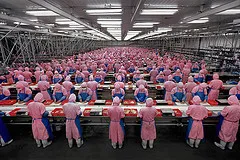
China’s industrial production plunges to three-month low of 13.5% in August
Production activities of heavy industries dropped from 14.5% in July to 13.5% in August.
HSBC says retail sales growth was in line with market expectation, moderating to 17.0% y-o-y in August from to 17.2% in July.
Here’s more from HSBC:
| On track for a soft landing Facts Heavy industries, which accounted for 70% of IP, reduced their production activities from 14.5% y-o-y in July to 13.5% in August, causing a 0.7ppt reduction in IP growth. On the other hand, light industries quickened to 13.4% y-o-y in August from 12.8% in July. By product, volume growth of most key items also slowed: production of electricity slowed to 10% y-o-y in August from 13.2% in July; steel production decelerated to 12.9% y-o-y from 14.9% in July, cement production cooled to 12.8% y-o-y in August from 16.8% in July; crude oil production slowed 4.5% y-o-y in August from 5.9% in July. Notably, car production expanded by 9.5% y-o-y, reversing a contraction of 1.3% in July, marking an end of inventory destocking and Japan's supply chain disruption. As we expected, credit tightening is curbing investment growth. Fixed investment growth slowed to 25.0% in the first eight months, in comparison to 25.4% for the first seven months (Jan to July) and Bloomberg consensus expectation of 25.2%. The implied single month growth rate decelerated to an eight-month low of 22.7% y-o-y in August from 24.5% in July. The real growth rate for fixed investment subsequently cooled to 15.4% y-o-y in August from 17% in July. Sequentially, fixed investment expanded 1.2% m-o-m sa in August versus 1.4% in July. Investment growth at the local level picked up to 28.1% y-o-y for the Jan to Aug period, versus 28.0% for the Jan to July period, while investment at the central level contracted further by 8.9% y-o-y for the Jan to Aug period, in comparison to a contraction of 4.7% for the Jan to July period. At the sector level, results were also mixed. Investment in the tertiary sector decelerated to 23.6% y-o-y for the Jan to Aug period, compared to 24.5% for the Jan to Jul period. In contrast, primary and secondary industries expanded 23% y-o-y (vs. 22.8% for the first seven months) and 27% y-o-y (vs. 26.7% for the first seven months), respectively, for the first eight months. Real estate investment slowed 33.2% y-o-y in Jan-Aug from 33.6% in Jan-Jul. On the other hand, residential property investment maintained speedy growth at 36.4% y-o-y in Jan-Aug thanks to Beijing's mandate to jumpstart all planned public housing construction projects by the end of November. Separately, growth of newly started investment projects accelerated to 23.1% y-o-y in the first eight months versus 19.3% in first seven months. Retail sales growth moderated to 17.0% y-o-y in August from to 17.2% in July, in line with market expectation. Seasonally adjusted m-o-m growth rate picked up 1.4% in August from 1.3% in July. In real terms, retail sales growth edged up to 10.8% y-o-y in August from 10.7% in July. Car sales expanded by 12.4% y-o-y in August, significantly more than 11.9% in July. Implications: In the mean time, we see limited downside growth risks for the following reasons: 1) The tightening cycle is close to an end, as CPI already peaked in July. Stable monetary policy is expected for the coming months. Plus, the current pace of credit growth of 15-16% is still sufficient to support around 9% GDP growth. 2) External demand is set to cool but not collapse. As such, we are still expecting China's exports to slow from above 20% y-o-y (July reading) to teens reading in the coming months. Faster growth of light industries and delivery value of exports implies that export growth for August is likely to remain robust. 3) Investment growth is set to slow further as tightening effects will continue to filter through. But it is just a slowdown not meltdown, thanks to massive ongoing infrastructure projects, the acceleration of public housing construction and robust consumption, which supports consumer-related investment. And the acceleration investment growth for newly started projects indicates that investment growth will be resilient in the coming months. 4) Domestic consumption has been very resilient thanks to tightened labour market and rapid economic growth. In recent years, China's GDP has become more consumption-driven (e.g., contributing 47.5% to GDP growth in 1H this year vs. 36.8% last year). And consumption is expected to be robust in the coming quarters for the following reasons: a) easing inflationary pressures (inflation peaked in July) will likely boost consumer confidence; and b) personal income tax adjustment, which will take effect in September, will also boost household income in the coming quarters. Meanwhile, inflation started to ease but will likely remain sticky well above the 4% official target. As such, we expect the PBoC maintain stable monetary policy in the coming months. Bottom line: China is well on track for a soft landing, with growth moderating and inflation peaking out. This is in line with our expectation of around 9% growth this year.
|
Photo from caffeineguy








![Cross Domain [Manu + SBR + ABF + ABR + FMCG + HBR + ]](https://cmg-qa.s3.ap-southeast-1.amazonaws.com/s3fs-public/styles/exclusive_featured_article/public/2025-01/earth-3537401_1920_4.jpg.webp?itok=WaRpTJwE)









 Advertise
Advertise


